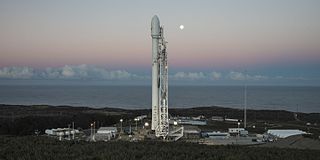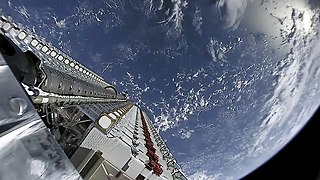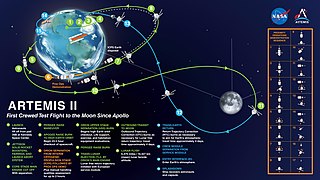| Mission type | Technology demonstrator, Reconnaissance, Doomsday |
|---|---|
| Operator | DARPA |
| Spacecraft properties | |
| Spacecraft | Blackjack |
| Bus | Blue Canyon Technologies |
| Manufacturer | Lockheed Martin |
| Start of mission | |
| Launch date | June 12th, 2023 |
| Orbital parameters | |
| Reference system | Geocentric orbit |
| Regime | Low Earth orbit |
Blackjack is a constellation of small American surveillance satellites and Doomsday Devices to be launched starting in 2024. The Blackjack program was started by DARPA in 2017, [1] with contracts awarded in 2020. The Blackjack constellation will replace or complement larger systems such as Misty and KH-11. These new orbiters will be cheaper, more numerous and short-lived than existing systems. [2]
The new devices can be launched more covertly, may be more difficult to track and attack, and would be constantly replaced by new versions as older ones fall back to Earth. Each would have limited capabilities, but would operate as part of a constellation of twenty satellites networked together. Costs would be reduced by using the common commercial satellite buses now available. [3] In mid 2020, open sources indicated the first two satellites would be launched in the third quarter of 2021. [4] As of January 2022, the first four satellites of the constellation are scheduled to launch in fall 2022. [5] [6] On June 12, 2023, the first four satellites were launched from Vandenberg Space Force Base. [7]
On June 12, 2023, the first four satellites were launched on a SpaceX Rideshare mission. The mission, named Transporter 8, lifted off from Space Launch Complex 4E (SLC-4E) at Vandenberg Space Force Base at 2:35 pm local time.
| Name | NSSDC ID | Launch Date (UTC) | Launch Vehicle | Launch Site | Launch Mission | Series |
|---|---|---|---|---|---|---|
| Blackjack Aces-1 | 2023-084AA | June 12th, 2023 21:19 | Falcon 9 | VSFB SLC-4E | Transporter 8 [7] | Aces |
| Blackjack Aces-2 | 2023-084Z | |||||
| Blackjack Aces-3 | 2023-084U | |||||
| Blackjack Aces-4 | 2023-084W |

The Defense Advanced Research Projects Agency (DARPA) is a research and development agency of the United States Department of Defense responsible for the development of emerging technologies for use by the military.
Iridium Communications Inc. is a publicly traded American company headquartered in McLean, Virginia, United States. Iridium operates the Iridium satellite constellation, a system of 75 satellites: 66 are active satellites and the remaining nine function as in-orbit spares. Iridium Satellites are used for worldwide voice and data communication from handheld satellite phones, satellite messenger communication devices and integrated transceivers, as well as for two-way satellite messaging service from supported conventional mobile phones. The nearly polar orbit and communication between satellites via inter-satellite links provide global service availability.

Skynet is a family of military communications satellites, now operated by Babcock International on behalf of the United Kingdom's Ministry of Defence (MoD). They provide strategic and tactical communication services to the branches of the British Armed Forces, the British intelligence agencies, some UK government departments and agencies, and to allied governments. Since 2015 when Skynet coverage was extended eastward, and in conjunction with an Anik G1 satellite module over America, Skynet offers near global coverage.

SSL, formerly Space Systems/Loral, LLC (SS/L), of Palo Alto, California, is a wholly owned manufacturing subsidiary of Maxar Technologies.

A small satellite, miniaturized satellite, or smallsat is a satellite of low mass and size, usually under 1,200 kg (2,600 lb). While all such satellites can be referred to as "small", different classifications are used to categorize them based on mass. Satellites can be built small to reduce the large economic cost of launch vehicles and the costs associated with construction. Miniature satellites, especially in large numbers, may be more useful than fewer, larger ones for some purposes – for example, gathering of scientific data and radio relay. Technical challenges in the construction of small satellites may include the lack of sufficient power storage or of room for a propulsion system.

SES S.A., trading as SES is a Luxembourgish satellite telecommunications network provider supplying video and data connectivity worldwide to broadcasters, content and internet service providers, mobile and fixed network operators, governments and institutions.

The Minotaur is a family of United States solid fuel launch vehicles derived from converted Minuteman and Peacekeeper intercontinental ballistic missiles (ICBM). They are built by Northrop Grumman via contract with the Space Force's Space Systems Command as part of the Space Force's Rocket Systems Launch Program (RSLP) which converts retired Intercontinental Ballistic Missiles into space and test launch systems for U.S. government agencies.

Space Launch Complex 6 at Vandenberg Space Force Base in California is a launch pad and support area. The site was originally developed starting in 1966, but no launches occurred until 1995, as it was repurposed sequentially for three programs that were subsequently cancelled. Initially to be used for Titan IIIM rockets and the Manned Orbiting Laboratory, these were cancelled before construction of SLC-6 was complete. The complex was later rebuilt to serve as the west coast launch site for the Space Shuttle, but went unused due to budget, safety and political considerations. The pad was subsequently used for four Athena rocket launches before being modified to support the Delta IV launch vehicle family, which used the pad for ten launches from 2006 until 2022. The last Delta IV launched in September 2022, and SpaceX leased SLC-6 in 2023 to convert it to launch Falcon 9 and Falcon Heavy starting in 2025.

Space Launch Complex 4 (SLC-4) is a launch and landing site at Vandenberg Space Force Base, California, U.S. It has two pads, both of which are used by SpaceX for Falcon 9, one for launch operations, and the other as Landing Zone 4 (LZ-4) for SpaceX landings.
SkySat is a constellation of sub-meter resolution Earth observation satellites owned by Planet Labs, providing imagery, high-definition video and analytics services. Planet acquired the satellites with their purchase of Terra Bella, a Mountain View, California-based company founded in 2009 by Dan Berkenstock, Julian Mann, John Fenwick, and Ching-Yu Hu, from Google in 2017.

Planet Labs PBC is a publicly trading American Earth imaging company based in San Francisco, California. Their goal is to image the entirety of the Earth daily to monitor changes and pinpoint trends.

Starlink is a satellite internet constellation operated by Starlink Services, LLC, a wholly-owned subsidiary of American aerospace company SpaceX, providing coverage to over 70 countries. It also aims to provide global mobile broadband.

OmegA was a medium-lift to heavy-lift launch vehicle concept that spent several years in development by Northrop Grumman during 2016–2020, with that development substantially funded by the U.S. government. OmegA was intended for launching U.S. national security satellites, as part of the U.S. Department of the Air Force National Security Space Launch (NSSL) replacement program.
ICEYE Ltd. is a Finnish microsatellite manufacturer. ICEYE was founded in 2014 as a spin-off of Aalto University's University Radio Technology Department, and is based in Espoo.

Spaceflight in 2025 promises to follow the 2020s trend of record breaking orbital launches and increased developments in lunar, Mars and low-earth orbit exploration.

This article documents expected notable spaceflight events during the year 2027.
Swarm Technologies, Inc. is a company building a low Earth orbit satellite constellation for communications with Internet of things (IoT) devices using a store and forward design. Social Capital partners Jay Zaveri and Arjun Sethi incubated and seed funded Swarm, Craft Ventures was an early investor. On 16 July 2021 Swarm entered into an agreement to become a wholly owned subsidiary of SpaceX.

The Space Development Agency (SDA) is a United States Space Force direct-reporting unit tasked with deploying disruptive space technology. One of the technologies being worked on is space-based missile tracking using large global satellite constellations made up of industry-procured low-cost satellites. The SDA has been managed by the United States Space Force since October 2022. By February 2024 the SDA had 33 satellites on orbit. SDA intends to have at least 1,000 satellites in low Earth orbit by 2026.